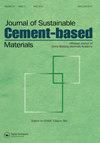Substitution of cement by marine clay in spray-based 3D concrete printing
IF 4.2
3区 工程技术
Q1 CONSTRUCTION & BUILDING TECHNOLOGY
Journal of Sustainable Cement-Based Materials
Pub Date : 2023-11-11
DOI:10.1080/21650373.2023.2278754
引用次数: 0
Abstract
AbstractSpray-based 3D concrete printing (S-3DCP) is a type of 3D concrete printing specifically for automated constructions on vertical and overhanging surfaces, e.g. facades and ceilings. In this study, cement is partially substituted by calcined marine clay to develop a high-performance mixture for S-3DCP. Through setting, rheological, and tack tests, the fresh properties of the mixtures with marine clays calcined after different temperatures have been assessed. Considering pumping and deposition performance, tackiness, and sustainability, the optimum calcination temperature of marine clay is determined as 700 °C. The subsequent spray-based printing test shows that compared with the mixture without marine clay, the mixture with the marine clay calcined at 700 °C has a more uniform thickness distribution and 185% higher building capacity. The study contributes to the deeper understanding of the rheological and tack properties of the mixtures with calcined marine clay, which guides the future utilization of marine clay.Keywords: Spray-based 3D concrete printingcementitious materialmarine clayrheological propertytackiness Disclosure statementNo potential conflict of interest was reported by the author(s).Data availability statementThe raw/processed data will be made available on reasonable request.AcknowledgmentsThe authors would like to acknowledge the Center for High Field NMR Spectroscopy and Imaging, Nanyang Technological University for the facility of Bruker AVANCE III HD 600 MHz (14.1 T) wide-bore spectrometer. The authors would also like to thank Mr. Hongliang Li for his valuable suggestions and Dr. Zhixin Liu for his assistance in spray-based 3D printing experiments.Additional informationFundingThis research is supported by the National Research Foundation, Prime Minister’s Office, Singapore under its Medium-Sized Centre funding scheme, CES_SDC Pte Ltd, and Chip Eng Seng Corporation Ltd.用海相粘土代替水泥在喷射基3D混凝土打印中的应用
摘要基于喷雾的3D混凝土打印(S-3DCP)是一种专门用于垂直和悬垂表面(如外墙和天花板)自动施工的3D混凝土打印。在本研究中,用煅烧的海相粘土代替部分水泥,开发出高性能的S-3DCP混合料。通过凝结、流变和粘性试验,评价了海相粘土经不同温度煅烧后的混合料的新鲜性能。考虑到泵送和沉积性能、粘性和可持续性,确定了海洋粘土的最佳煅烧温度为700℃。随后的喷印试验表明,与不含海相粘土的混合物相比,加入700℃煅烧海相粘土的混合物厚度分布更均匀,建筑能力提高185%。该研究有助于深入了解煅烧海相粘土混合料的流变特性和粘性特性,指导海相粘土的进一步利用。关键词:喷射式3D混凝土打印胶凝材料海洋粘土流变特性粘性披露声明作者未报告潜在利益冲突数据可用性声明应合理要求,我们会提供原始/处理过的数据。作者感谢南洋理工大学高场核磁共振波谱与成像中心为我们提供了Bruker AVANCE III HD 600 MHz (14.1 T)宽口径光谱仪。作者还要感谢李洪亮先生提出的宝贵建议和刘志新博士在喷雾3D打印实验中的协助。本研究由新加坡国家研究基金会、新加坡总理办公室的中型中心资助计划、CES_SDC Pte Ltd和Chip Eng Seng Corporation Ltd支持。
本文章由计算机程序翻译,如有差异,请以英文原文为准。
求助全文
约1分钟内获得全文
求助全文
来源期刊
CiteScore
6.60
自引率
15.90%
发文量
71
期刊介绍:
The Journal of Sustainable Cement-Based Materials aims to publish theoretical and applied researches on materials, products and structures that incorporate cement. The journal is a forum for discussion of research on manufacture, hydration and performance of cement-based materials; novel experimental techniques; the latest analytical and modelling methods; the examination and the diagnosis of real cement and concrete structures; and the potential for improved cement-based materials. The journal welcomes original research papers, major reviews, rapid communications and selected conference papers. The Journal of Sustainable Cement-Based Materials covers a wide range of topics within its subject category, including but are not limited to: • raw materials and manufacture of cement • mixing, rheology and hydration • admixtures • structural characteristics and performance of cement-based materials • characterisation techniques and modeling • use of fibre in cement based-materials • degradation and repair of cement-based materials • novel testing techniques and applications • waste management

 求助内容:
求助内容: 应助结果提醒方式:
应助结果提醒方式:


